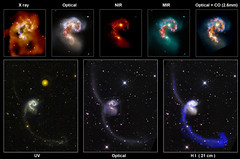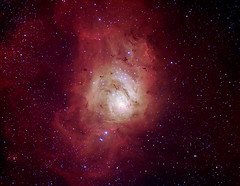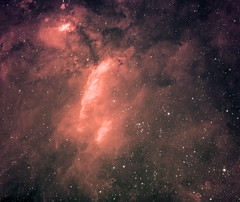Last 23rd March 2013 I was invited to give a Public Talk at Sydney Observatory because of the Earth Hour 2013. More than 200 people attended this event, I have to say I think it was not because of me but because of the possibility of getting a somewhat darker sky than usual in the city center. Earth Hour is a worldwide event organized by the World Wide Fund for Nature (WWF) that encourages households and businesses to turn off their non-essential lights for one hour. The aim of this is to raise awareness about the need to take action on climate change and, in particular, the problem of the light pollution. The Earth Hour first took place in 31st March 2007 in Sydney, which has a participation of 2.2 million Sydneysiders. In 2008 many other cities around the world adopted the event, creating a movement in which now participates around 1 billion people in more than 150 countries.
What is light pollution? It can be defined as the excessive or inappropriate outdoor lighting. Common forms of light pollution include glare, sky glow, light trespass, and light clutter. As the International Dark Sky Association (IDA) specifies in its main brouchure
Urban dwellers everywhere are losing the ability to see planets and stars in the night sky. The spectacular view of the Cosmos that has inspired science and art throughout history is disappearing. The glow of uncontrolled outdoor lighting has hidden the stars and changed our perception of the night. Light pollution wastes energy ( = MONEY! ), harms ecosystems, increases greenhouse gasses, threatens astronomical research and affect human health. Better lightning is the solution! The problems from light pollution can be solved by utilizing efficient, modestly bright outdoor lighting fixtures that are directed toward the ground and shielded to control glare.

Empire State Building in New York city at night. The light pollution is a terrible problem in large cities, giving the sky that orange colour. Sadly, today many children think that this is the real color of the night sky. Picture taken in October 2004.
Credit: Charliebrown7034 (Wikipedia).
Beside the negative effect that the light pollution has in the environment and its effects in animals and persons, I want to emphasize that its main consequence (at least, that which sadly is more important) is the
huge amount of money which is wasted to illuminate the clouds and hide the stars. People around the world are realizing that this stupid kind of pollution has an easy solution. However it is responsibility of we, scientists, to talk about this to the general public and also to our Governments. Following the document
Public Lighting—Energy Efficient Street Lighting published in July 2008 by the Australian Government,
In Australia, public lighting is the single largest source of local government’s greenhouse gas emissions, typically accounting for 30 to 50% of their CO2 emissions. There are 1.94 million public lights — one for every 10 Australians — that annually cost A$210 million, use 1,035 GWh of electricity and are responsible for 1.15 million tonnes of CO2 emissions.

Photos comparing the vision of the Sydney Harbour Bridge and the Sydney Opera House during the Earth Hour on 28th March 2003 (top row) and after that event (bottom row). All 4 images were taken from the same place using a camera CANON EOS 400D, 400 ISO, f10 and 20 seconds exposure. The decreasing of the light pollution (seen specially well in the clouds) is quite evident.
Credit: Á.R.L-S. (AAO/MQ)
I emphasized, however, that the light pollution in Australia is (still) not bad at all. Australia has some of the darkest places on Earth (I was really impressed about how stars shine from the Australian Desert), are indeed Sydney, which has 4.5 million people, has by far better night skies that those seen from the city I’m from, Córdoba (Spain), with only 350 thousand people. As an example, just check this image I took in 2011 New Year Eve from the Opera Bar, just downstairs of the Sydney Opera House

Vision of the Sydney Opera House from the Opera Bar on the 2011 New Year Eve. It is just a 10 seconds exposure at f6.3 and 400 ISO using a CANON EOS 400D camera. The main stars of the Orion and Taurus (The Bull) constellations are clearly seen, as well as the Pleiades and even the Orion Nebula as a diffuse dot!
Credit: Á.R.L-S. (AAO/MQ)
After discussing the light pollution, its effects and some projects aimed to reduce it, I used the second half of my time to talk about my research at the Australian Astronomical Observatory / Macquarie University. I explained what an astronomer usually does, where the Siding Spring Observatory is, and presented some results of my own research about star-formation in galaxies.

A moment during my Public Talk at Sydney Observatory on 23rd March 2013 just before the Earth Hour. I was explaining here the problem of the light pollution, although later I talked about my research and work at the Australian Astronomical Observatory and Macquarie University.
Credit: Jeanette Landstedt (Sydney Observatory).
After the talk the participants enjoyed some stargazing using the amateur telescopes provided by the Sydney Observatory. I was among them and couldn’t stop talking to one and another group, as I was still being asked about what I said during my talk. It was great to be able to do this in the very relaxing atmosphere of an amateur observation. The only bad thing was that there was still a lot of light coming from the Moon, indeed, choosing the weekend before Easter for the Earth Hour was not good as it was not possible to really check the actual difference induced by the deficit of illumination in the sky.

























